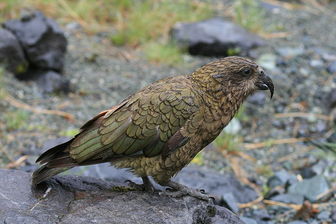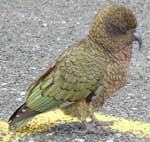Kea
Kea are known for their intelligence and curiosity, both vital to their survival in a harsh mountain environment. Kea can solve logical puzzles, such as pushing and pulling things in a certain order to get to food, and will work together to achieve a certain objective.

Original source: Milford Sound, Key Summit, The Divide, Queenstown
Author: Mark Whatmough
 Why do animals play? A theory says that playing exercises abilities,
Why do animals play? A theory says that playing exercises abilities,
which are important for survival. That's certainly correct; a lot of
young animals practice their abilities to hunt and fight by playing.
But also adult animals do play and sometimes it seems that besides
exercising courses of motion and behaviour flows, pure fun might be the
deciding cause. But there is a restriction concerning the occurrence of
playing; animals do only play when there are no other important demands
of life, which have to be fulfilled, like escaping from predators,
finding food and so on. Most mammals show a more or less well-developed
playing behaviour. But playing birds are rather unusual. One of the
best-known exceptions is the Kea. And Keas really enjoy playing;
everything arousing their interest is examined very closely and romping
around in the snow is one of their favourites. While playing they move
with clownish clumsiness and communicate using all kinds of sounds.
Their best-known call, which also gave them their name, is a squawking
"keeaah" while flying. Keas are also very curious and tame towards man;
they approach hikers and mountaineers almost without any timidity.
The Kea and its close relative, the Kaka (Nestor meridionalis), are
regarded as members of a primitive group of parrots. They don't seem to
be very closely related to other parrot species. Keas are up to 46 cm
long. The dominating colour of their plummage is olive-green. The Kea's
feathers are hemmed, which gives a scale-like appearance to the
plummage. The wings' undersurface is speckled in a reddish colour.
Noticeable is the long, slender upper beak. Keas inhabit alpine regions
in the southern part of New Zealand. They prefer the meagre habitats
above the timber line, where they have to fear little competition by
other bird species. These regions are characterized by a harsh climate,
which confronts the Keas with cold, wind and snow.
Keas are group living birds. Males are polygamous and mate with several
females. This is rather unusual among birds too. Most bird species are
monogamous and a partnership lasts for a lifetime in some species. Keas
are able to reproduce all year. They build their nests in crevices and
ground holes. The two to four eggs are incubated by the female for
three to four weeks. The nestlings stay in the nest for about two
weeks. Although Keas are not dependent on a certain breeding season,
they do not breed very often. There might be two or even more years
going by until a female tries another brooding. The cause of this
behaviour can be found in the meagreness of the living conditions the
Keas are confronted with. There probably has to be a long break to be
ready to accomplish another brooding.
The Keas' diet was the cause of many legends and controversies. Their
principal food is of vegetarian origin, most of all berries and shoots;
but Keas also take animal supplementary diet. There are a lot of sheep
breeding in New Zealand, even in the mountain regions where the Keas
live. There are a lot of accidents and deaths among the sheep in this
harsh and dangerous environment. Keas often feed on sheep carcasses.
The meat is an important source of protein and energy for them. But
they are also accused of injuring sheep which are still alive. The
wounded sheep are said to die by loss of blood and infections. This
can't be denied completely; there are even film records of such a
behaviour. But there also have been a lot of exaggerations. However the
Keas' behaviour was used as an opportunity to intensify shooting.
Thousands of Keas have been shot in the mountain regions of New
Zealand, but the unusual birds are still quite numerous, especially in
the more inaccessible regions, where they still amaze hikers and
mountaineers with their tricks.
This article was originally published at magazine.naturspot.de. Link
to the original article
The Kea is classified as Vulnerable (VU), considered to be facing a high risk of extinction in the wild.

Family : Psittacidae
Genus : Nestor
Species : notabilis
Authority : Gould, 1856
